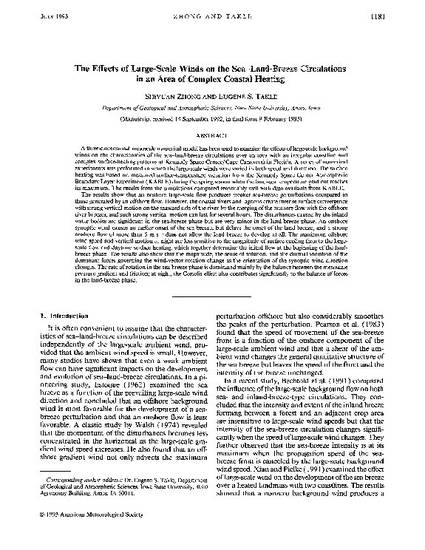
A three-dimensional mesoscale numerical model has been used to examine the effects of large-scale background winds on the characteristics of the sea-land-breeze circulations over an area with an irregular coastline and complex surface-heating patterns at Kennedy Space Center/Cape Canaveral in Florida. A series of numerical experiments was performed in which the large-scale winds were varied in both speed and direction. The surface heating was based on measured surface-temperature variation from the Kennedy Space Center Atmospheric Boundary Layer Experiment (KABLE) during the spring season when the land-sea temperature gradient reaches its maximum. The results from the simulations compared reasonably well with data available from KABLE.
The results show that an onshore large-scale flow produces weaker sea-breeze perturbations compared to those generated by an offshore flow. However, the coastal rivers and lagoons create intense surface convergence with strong vertical motion on the seaward side of the river by the merging of the onshore flow with the offshore river breezes, and such strong vertical motion can last for several hours. The disturbances caused by the inland water bodies are significant in the sea-breeze phase but are very minor in the land-breeze phase. An onshore synoptic wind causes an earlier onset of the sea breeze, but delays the onset of the land breeze, and a strong onshore flow of more than 5 m s−1 does not allow the land breeze to develop at all. The maximum offshore wind speed and vertical motion at night are less sensitive to the magnitude of surface cooling than to the large-scale flow and daytime surface heating, which together determine the initial flow at the beginning of the land-breeze phase. The results also show that the magnitude, the sense of rotation, and the diurnal variation of the dominant forces governing the wind-vector rotation change as the orientation of the synoptic wind direction changes. The rate of rotation in the sea-breeze phase is dominated mainly by the balance between the mesoscale pressure gradient and friction; at night, the Coriolis effect also contributes significantly to the balance of forces in the land-breeze phase.
Available at: http://works.bepress.com/eugene-takle/94/

This article is published as Zhong, Shiyuan, and Eugene S. Takle. "The effects of large-scale winds on the sea–land-breeze circulations in an area of complex coastal heating." Journal of Applied Meteorology 32, no. 7 (1993): 1181-1195. DOI:10.1175/1520-0450(1993)032<1181:TEOLSW>2.0.CO;2. Posted with permission.